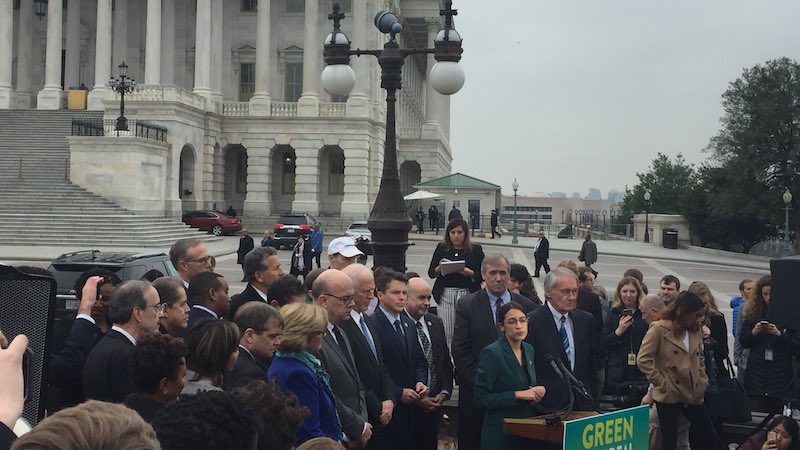Our nation has a long history of scientific innovation that has produced the computers that run our businesses, new discoveries in medicines that can extend our lives, and the rockets that take us to distant worlds in search of other life.
In short, science is our best hope to enable informed choices about our future. Big ideas like president Roosevelt’s New Deal also gave our nation hope for reversing the downward economic spiral of the 1930s with government programmes that still benefit us today. However, when it comes to a safe climate, science and policy have operated in a vacuum.
The Green New Deal in Congress provides an opportunity for bringing both science and policy together in shaping a sustainable future for our nation that avoids a pending crisis to the planet’s life support systems if we do not act boldly and promptly.
For decades, scientists have been monitoring the planet’s life support systems using satellite images of how we are transforming forests, rivers and oceans over vast areas, and thousands of instruments around the globe to track the climate. Reading these signals like the warning lights on a car’s dashboard, 1,700 eminent scientists were alarmed enough to issue a warning in 1992. “A great change in our stewardship of the earth and the life on it is required,” it stated, “if vast human misery is to be avoided.”
A second warning was issued in 2017 that the planet’s climate and natural systems were indeed worsening. It was signed by more than 21,000 scientists from 184 countries. Referring to these same signals, Sir David Attenborough, the 92-year-old naturalist and broadcaster, a man not given to drama or hyperbole, opened the UN’s Katowice Climate Conference in December 2018 by stating: “If we don’t take action, the collapse of our civilizations and the extinction of much of the natural world is on the horizon.”
Fortunately, forward-thinking members of Congress recently introduced a bold resolution that responds to the climate challenge at scale. Aptly named a Green New Deal, it is as ambitious as president Roosevelt’s New Deal in the 1930s. It comprehends the magnitude of the climate threat humanity faces, and we see it as a sign of realism – not radicalism – that the problem is viewed in its totality and with urgency.
The Green New Deal recognizes that environmental policies are an important part of a broader social and economic fabric that must work together to transition the economy to renewable energy empowered by innovation, a “green” workforce, and proactive businesses. While there are gaps to be filled, by calling for carbon-free energy, clean air and clean water and an economic system that addresses inequalities, the proposal is the most comprehensive response yet to the scientists’ warnings.
Global issues need global coverage
CHN is dedicated to bringing you the best climate reporting from around the world. It’s a huge job and we need your help.
Through our Patreon account you can give as little or as much as you like to support our work. It’s safe and easy to sign up.
As daring and impudent as a moonshot, the Green New Deal is a breath of fresh air in changing the political conversation to how we should quickly address the climate crisis. As a first priority, there is an urgent need for Congress to follow up with immediate legislation to curb greenhouse gas emissions with a fair, equitable and effective scheme for carbon pricing and by enlisting nature in comprehensive climate solutions.
Recent experience shows what can be accomplished in transforming the energy sector. In 2009, Congress included $90 billion for renewable energy research and development in the American Recovery and Reinvestment Act. Wind and solar energy grew from 2% of America’s total electricity production then to 8% in 2017. The energy sector’s carbon dioxide emissions dropped 28%, despite a rising population and a larger economy.
National forest roadless areas and older forests on public lands also need to be protected as climate insurance. These pristine areas absorb massive amounts of carbon dioxide, helping to cool the planet, and they provide clean drinking water to millions of citizens that will only become even more precious with extended droughts. Tidal wetlands and mangroves buffer communities from rising seas and they too need to be properly stewarded and restored. Agricultural lands can do their part in storing more carbon in soils through minimum tillage and providing wildlife habitat with landowners rewarded through Farm Bill incentives. In sum, the Green New Deal is a means for leveraging these important outcomes.
Guided by science, policy makers now need to solicit input from social-environmental justice, labour and other organizations to fine-tune and activate the Green New Deal as a unique opportunity to turn the planet’s warning lights off. It’s the best deal we have for a safe climate, equitable society, and thriving planet.
William J. Ripple, PhD, distinguished professor of ecology, Oregon State University, was the lead author of the 2017 World Scientists’ Warning to Humanity: A Second Notice. Dominick A. DellaSala, PhD, chief scientist, Geos Institute, Ashland, Oregon has over 200 science publications and has been an expert witness at forest and climate change hearings. Franz Baumann, PhD, former United Nations assistant secretary-general, is a visiting research professor at New York University.
Note: the article was amended to reflect the fact that solar and wind produced 8% of electricity production, not 10% of all energy production as previously stated.
